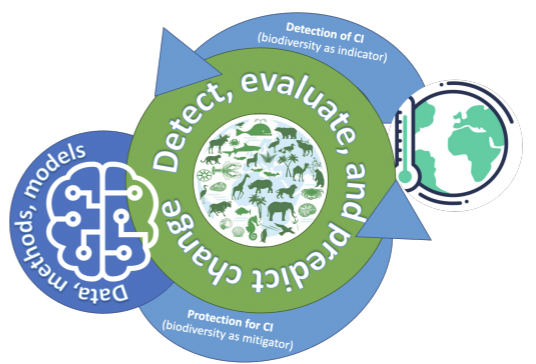MIT CSAIL will join a new international center devoted to using artificial intelligence to help understand climate impacts on biodiversity.
Led by Ohio State University, the AI and Biodiversity Change (ABC) Global Climate Center will bring together ecologists and computer scientists from six universities in the United States and Canada, with partners in the United Kingdom, Europe, and Australia to develop new AI-enabled, data-supported approaches to study how changes in climate are impacting life — including animals, plants and insects — on Earth.
The ABC will establish a community-engaged and multi-sector stakeholder-co-designed framework for monitoring, analyzing, and assessing the impact of climate change on biodiversity through AI-enabled, data-supported approaches at large scale and high resolution across
space, time, and units of life. ABC’s stakeholder co-designed framework will focus on addressing four specific but broadly applicable biodiversity research questions that can benefit significantly from the inclusion of new AI methods:
1. Elucidating drivers of range boundaries for hard-to-detect species.
2. Understanding change in functional diversity while including under-surveyed species.
3. Detecting early warning signals of northward range shifts.
4. Quantifying changes in species interactions.
Researchers in the project will conduct fundamental AI research and develop and use new AI-based methods and tools to analyze data from camera traps, sound recorders, images from satellites and low-flying aircraft, DNA sequences, and citizen science efforts.
They will study 222 species of birds, mammals, amphibians, and reptiles that currently breed within 800 km (about 500 miles) of the border. The researchers will subsequently use AI analysis of satellite images and extend ecological models to determine how habitat changes might influence the northward movement of species.
CSAIL’s Sara Beery, the Homer A. Burnell Career Development Professor in MIT's Faculty of AI and Decision Making, is a co-principal investigator of the project.
“We are at a point now where AI models are being actively used in biodiversity monitoring systems globally, but there are still many challenges in biodiversity monitoring that our best AI methods still cannot solve,” says Beery. “This Global Climate Center provides the opportunity to bring together researchers from both AI and Ecology to tackle these difficult, open challenges. In particular, I'm so excited about the focus of the center on understanding biodiversity change and its interplay with climate change. This additional complexity of not just identifying species in diverse data modalities, but also capturing and understanding how those species ranges and populations are changing, is an exciting challenge."
As part of the ABC, Beery and her lab at CSAIL will be leading the development of novel machine learning and computer vision methods that tackle the major challenges and limitations of current state-of-the-art AI methods, which are significant bottlenecks in scaling up biodiversity monitoring globally. Biodiversity data presents several key challenges that align closely with basic research questions in AI, and these questions will be the focus of Beery's research. Beery will also take part in the leadership of education initiatives intended to increase research capacity at the intersection of these two fields as part of the Global Center, with her ongoing Summer Workshop on Computer Vision for Ecology also receiving support from the center.
The project includes more than 50 partners in the UK, Australia, Africa, India, Central America, and the European Union. These partners are not just in academia, but also in governments, non-governmental organizations, and industry. The partners will provide research collaboration networks, field data collections, data curation and hosting, community building, access to computational resources, tech transfer and open source tool development, and education and capacity building.
The new center will be a multimillion-dollar project. About $5 million was awarded by the National Science Foundation to researchers at Ohio State as the lead institution, as well as the University of Pittsburgh and MIT. About $3.75 million was awarded by the Natural Sciences and Engineering Research Council of Canada to researchers at McGill University, the University of Guelph, and the University of British Columbia. The team also includes core partners in the UK from the University of Bristol and the University of Edinburgh, as well as the University of Monash in Australia, EPFL in Switzerland, and WILDLABS.



